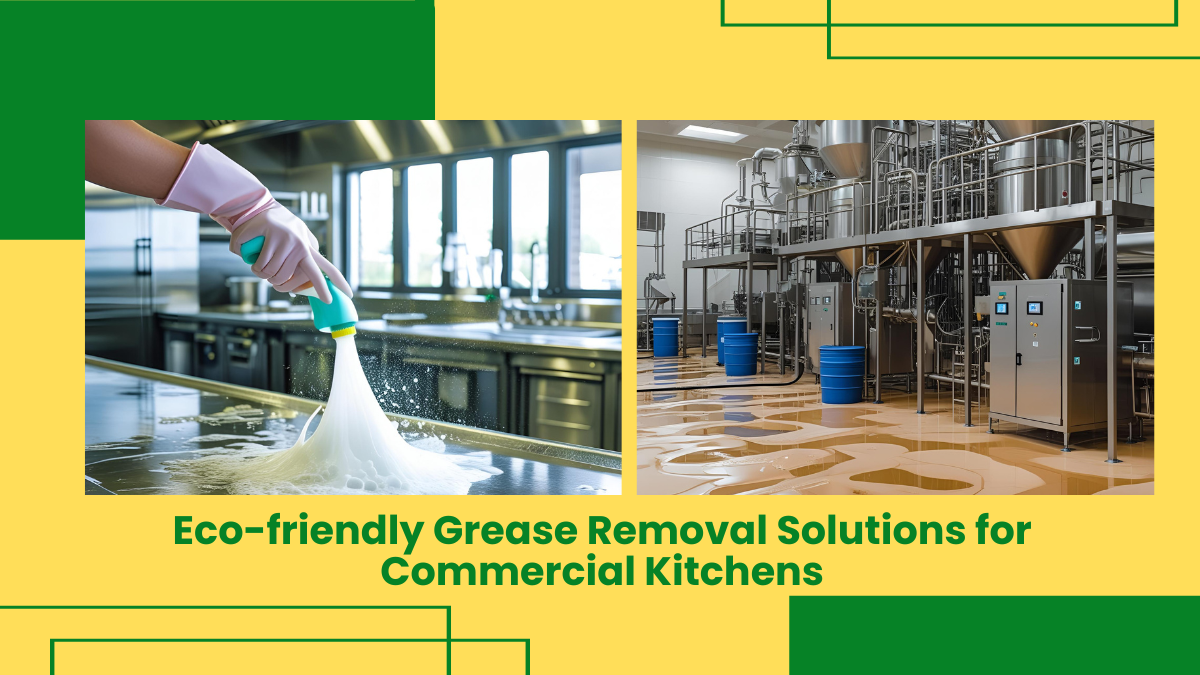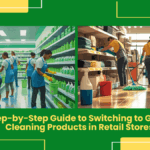Maintaining a clean commercial kitchen goes beyond appearance. Grease buildup affects hygiene, safety, equipment performance, and environmental compliance. Traditional degreasers can tackle heavy soils but often involve harsh ingredients, strong odors, and extensive rinsing. Eco-friendly grease removal methods deliver effective cleaning while reducing environmental impact and protecting staff health. Below, explore common grease-related challenges, practical eco-friendly solutions, preventive measures, and how Ecochem’s digital signage platform can support streamlined cleaning operations.
Common Grease Challenges in Commercial Kitchens
Safety and Slip Risks
Grease on floors and work surfaces creates slippery conditions. Staff moving quickly can slip, leading to injury. Prompt cleaning is essential, yet heavy buildup demands frequent attention.
Fire Hazards
Accumulated grease on hoods, ducts, and exhaust fans increases fire risk. Grease is combustible; even small flames or high heat near deposits can ignite a fire. Regular removal is critical for safety and compliance with fire codes.
Equipment Performance and Costs
Grease on burners, grills, and ovens impairs heat transfer, causing uneven cooking and longer cook times. Over time, this raises energy use and stresses equipment. Persistent buildup can lead to breakdowns and repair expenses.
Environmental Impact and Regulations
Discharging grease-laden wastewater can harm sewer systems and local ecosystems. Many jurisdictions mandate effective grease trap management and limit harmful chemicals in cleaning agents. Kitchens aiming for sustainable operations need eco-friendly cleaning options.
Eco-friendly Grease Removal Solutions
Balancing powerful grease removal with low environmental impact involves selecting the right products and methods. Below are approaches that address grease effectively while aligning with green practices.
Biodegradable Degreasers
- Plant-derived Surfactants: Formulations use natural surfactants from citrus, soy, or other plant oils. They reduce surface tension to lift grease without harsh solvents.
- Minimal Residue: These cleaners rinse off cleanly, avoiding slippery films and reducing water use.
- pH Considerations: Many maintain a mild alkaline or neutral pH, safe on stainless steel, tile, and sealed countertops.
- Application Tips: Apply to cooled surfaces, allow brief dwell time, then wipe or rinse. For heavy buildup, repeat gently to avoid surface damage.
Enzyme and Microbial Treatments
- Enzyme Action: Enzymes target fats, oils, and grease molecules, breaking them into water-soluble fragments. Used in drains or on surfaces, they ease removal and help prevent backups.
- Microbial Solutions: Beneficial microbes consume grease in traps or wastewater lines, reducing manual maintenance and extending service intervals.
- Safety Profile: Non-toxic and biodegradable, enzyme products are safe around food-prep areas when used per instructions.
- Use Cases:
- Grease Traps: Regular enzyme dosing limits solid buildup, reducing pump-out frequency.
- Surface Prep: Enzyme sprays loosen old grease on hoods or grills before manual cleaning.
- Drains: Periodic microbial treatments help maintain clear pipes.
- Grease Traps: Regular enzyme dosing limits solid buildup, reducing pump-out frequency.
Mechanical and Steam Methods
- High-Temperature Steam: Steam cleaners soften grease without chemicals. Properly managed, steam reduces reliance on degreasers and cuts water use. Ensure materials tolerate heat.
- Scrubbing Tools: Brushes, scrapers, and microfiber pads enhance removal of loosened grease. Pair with eco-friendly cleaners for best results.
- Ultrasonic Cleaning: For small parts like fryer baskets or utensils, ultrasonic baths with mild biodegradable detergents reach crevices and dislodge grease.
Green Solvent Alternatives
- Bio-based Solvents: Renewable-source solvents can dissolve stubborn grease where water-based cleaners struggle. They should biodegrade readily and have low toxicity.
- Spot Treatment: Use sparingly on localized heavy deposits, then follow with biodegradable degreaser to remove residues.
- Ventilation Needs: Even mild solvents may emit light odors; ensure adequate airflow. Ecochem signage can remind staff to ventilate during solvent use.
Combined Formulations
- Multi-Ingredient Blends: Some eco-friendly cleaners mix surfactants, enzymes, and mild solvents for balanced performance. These versatile products work on various surfaces: stainless steel, tile, and sealed wood.
- Concentrates and Packaging: Concentrated solutions reduce packaging waste and transport footprint. On-site dilution saves storage space and tailors strength to task.
Practical Cleaning Protocols
A structured approach ensures eco-friendly grease removal is effective and consistent. Integrating protocols with Ecochem’s digital signage platform helps coordinate tasks and maintain accountability.
Zone Assessment and Scheduling
- Identify High-Grease Areas: Map cooking lines, fryers, grills, hoods, and exhaust ducts. Note spots prone to splatter or hidden buildup.
- Daily Tasks:
- Wipe down cooking surfaces after service with biodegradable degreaser.
- Clean spills immediately using quick-acting eco-friendly wipes or sprays.
- Sweep and mop floors with low-residue cleaner to prevent tracked grease.
- Wipe down cooking surfaces after service with biodegradable degreaser.
- Weekly Tasks:
- Remove and soak hood filters in biodegradable solution or enzyme bath; rinse and reinstall.
- Treat drains with enzyme or microbial product to break down accumulated grease.
- Remove and soak hood filters in biodegradable solution or enzyme bath; rinse and reinstall.
- Monthly Tasks:
- Deep-clean ducts and hoods (in-house or professional) per fire code.
- Steam clean equipment exteriors and walls near cooking zones.
- Inspect grease traps and schedule pump-outs as needed.
- Deep-clean ducts and hoods (in-house or professional) per fire code.
- Quarterly Reviews:
- Audit cleaning effectiveness: check for stubborn grease spots.
- Review supply levels of eco-friendly cleaners and reorder based on usage trends.
- Audit cleaning effectiveness: check for stubborn grease spots.
Staff Training and Communication
- Clear Instructions: Provide step-by-step mixing and application guidelines. Use concise language and visuals.
- Digital Signage Displays: Through Ecochem, show short how-to clips or infographics in staff areas, reinforcing correct cleaning sequences.
- Safety Precautions: Even mild cleaners may need gloves; state required PPE. Post reminders on screens.
- Feedback Channels: Use quick digital polls on Ecochem screens to gather staff input on product performance or process issues.
Add Glitter To Dishwasher!
Cleaning dirty and oily utensils are yet another challenge post fulfilling the food lovers. Ecochem has made the work easy with organic chemicals for cleaning named Eco-Glitter(Dishwasher Gel). Our bio-based cleaning products efficiently fights tough stains and oil from the metal surfaces adding shine to the dishware. The natural fragrance of lemon gives the surfaces a freshness and also help easy wash of oily food stains from the utensils.
Make Air Green with Green Air!
Making of odors is not a solution when it comes to Air Fresheners. EcoChem with a thought to unmask the foul smells with Eco-Green Air which is one among the best bio-based products for multi-purpose air fresheners. The chemical-based air fresheners that are available in the market create a coating on the nasal membrane and insists the brain think that the foul smell is gone.
Integrating Ecochem’s Platform for Cleaning Operations
Ecochem’s digital signage connects to multiple apps, enabling real-time coordination and visibility across the kitchen environment.
Task Assignment and Alerts
- Dynamic Schedules: Publish daily cleaning tasks on screens in prep rooms or supervisor stations, guiding staff at shift start.
- Immediate Alerts: If a spill is reported via a mobile form, Ecochem can display a cleanup alert on nearby screens, prompting swift action.
- Shift Handover Notices: Display pending tasks to ensure seamless transitions between shifts, preventing missed cleaning steps.
Training and Reminders
- Video and Infographics: Host brief training modules on eco-friendly grease removal techniques. Rotate content on screens in break areas to reinforce practices.
- Quiz Prompts: Occasionally display a question about safe cleaning methods, keeping staff engaged and informed.
Inventory and Procurement
- Stock Monitoring: Integrate with inventory systems to track eco-friendly cleaner levels. When low, Ecochem can prompt reorder or display procurement reminders.
- Usage Analytics: Link cleaning logs to consumption data. If unexpected high use appears, investigate possible inefficiencies.
Incident Tracking and Analytics
- Grease Trap Alerts: Use sensor data or manual entries to signal when traps near capacity. Ecochem displays reminders to schedule service.
- Safety Incident Reports: Log slip incidents due to grease; Ecochem can highlight extra cleaning needed in specific zones.
- Performance Dashboards: Management views trends in cleaning time, equipment downtime, and incident rates, enabling data-driven adjustments.
Compliance and Documentation
- Digital Records: Archive cleaning checklists, photos of cleaned areas, and batch details of products used. Screens can show audit summaries to staff.
- Policy Updates: When regulations change (e.g., fire safety or wastewater rules), Ecochem pushes brief alerts summarizing new steps or documentation requirements.
Prevention Tips to Minimize Grease Buildup
Proactive practices reduce deep-clean frequency, saving time and resources.
Equipment Care
- Filter Maintenance: Replace or clean hood filters promptly to prevent grease reaching ducts.
- Seal Checks: Inspect seals around ovens, fryers, and grills for leaks; repair to stop grease escape.
- Professional Servicing: Schedule routine servicing to detect hidden grease deposits and maintain performance.
Workflow Practices
- Fryer Management: Use baskets and lids to limit splatter. Filter oil regularly to reduce sludge.
- Pre-Cleaning Steps: Scrape excess grease before applying cleaners to reduce workload.
- Spill Containment: Place mats or trays under high-grease equipment. Clean these daily with biodegradable degreaser.
- Proper Disposal: Collect used cooking oil separately; do not pour into drains. Use designated containers for recycling or disposal.
Design Considerations
- Surface Selection: Favor non-porous materials like stainless steel or sealed tile to prevent grease absorption.
- Floor Finishes: Choose slip-resistant flooring and maintain it to preserve traction even if minor grease remains.
- Access to Cleaning: Arrange equipment to allow easy reach behind and under devices, avoiding hidden grease pockets.
Staff Engagement
- Immediate Response Culture: Encourage reporting and prompt cleanup of spills. Provide portable eco-friendly wipes for quick action.
- Accountability: Assign cleaning duties per shift and display completion status on Ecochem screens. Rotate tasks to distribute workload.
- Recognition: Highlight staff who excel at preventive cleaning, reinforcing positive habits.
Final Thoughts
Adopting eco-friendly grease removal solutions enhances kitchen safety, equipment longevity, and environmental responsibility. Biodegradable degreasers, enzyme treatments, steam methods, and green solvents tackle grease effectively while reducing harmful residues and wastewater impact. Preventive practices—filter maintenance, spill containment, and staff engagement—keep buildup minimal. Integrating Ecochem’s digital signage platform ensures clear communication of schedules, training, and alerts, boosting accountability and efficiency. Tracking cleaning metrics and feedback supports continuous improvement. With these approaches, commercial kitchens stay clean, safe, and aligned with sustainability goals without sacrificing performance.
FAQ’S
What are eco-friendly grease removal solutions?
Eco-friendly grease removal uses biodegradable degreasers, enzymes, and steam methods, ensuring effective cleaning while protecting staff health and environment quality.
How often should commercial kitchens perform grease removal?
Perform daily eco-friendly grease removal on high-use areas, weekly deep clean hoods and filters, monthly enzyme drain treatments for safety.
Are enzyme treatments effective for drains?
Enzyme treatments break down fats and oils, preventing clogs, reducing manual maintenance, and extending grease trap service intervals sustainably efficiently.
How to integrate cleaning protocols with digital signage?
Use Ecochem signage to display schedules, share eco-friendly grease removal steps, send alerts for spills, and collect staff feedback regularly.
What preventive tips minimize grease buildup?
Maintain hood filters, enforce immediate spill cleanup with eco-friendly wipes, schedule regular equipment servicing, and educate staff consistently for efficiency.
Written By: vinny Jain


